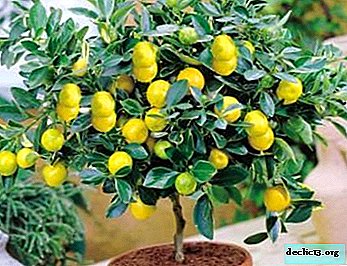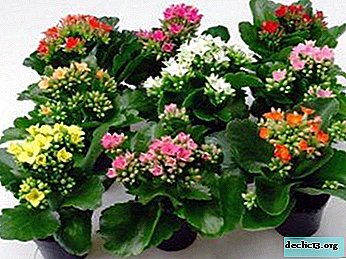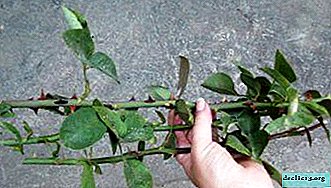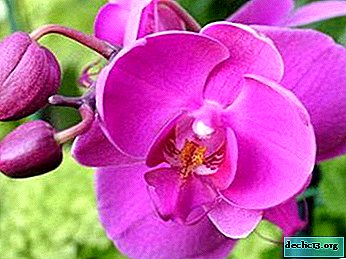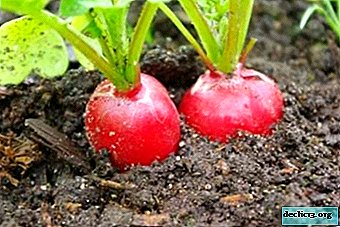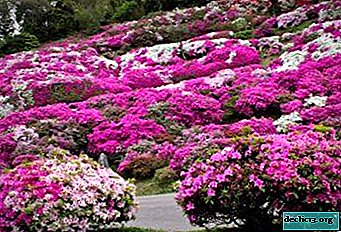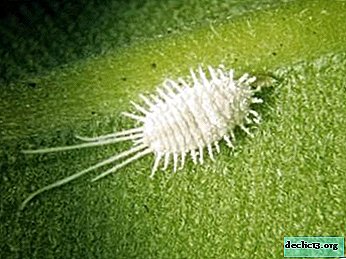Expressive rose First Lady: description and photo of the variety, use in landscape design, care and other nuances

First Lady stands out among other tea hybrid roses with stunning flowering. Shrubs with large pearly flowers cause delight and admiration.
Using a rose of this species only, you can create an expressive composition in the garden.
The article provides a detailed description and photo of the variety, the history of occurrence. You will learn how to care for this flower, propagate, and also fight diseases and pests.
Detailed description and photo varieties
First Lady - Hybrid Tea Cutting Rose. The bush is rounded, grows very quickly. The height of an adult rose can be from 120 to 150 cm, width from 100 to 120 cm. The stalks are arched. The flowers are large, with a diameter of up to 10 cm, densely double.
Petals have a pale pink color, on the edges they are almost white, closer to the center the pink tone gradually becomes more saturated. Due to the large number of petals, the buds are dense and open very slowly. Coloring flowers does not fade in the sun. The flowers tolerate rain well.
Pros First Lady:
- high decorativeness;
- disease resistance;
- winter hardiness;
- repeated flowering;
- the buds are not damaged by rain;
- each flower lasts longer than a week;
- suitable for cutting.
Minuses:
- grows quickly and requires a lot of space;
- supports are necessary during a period of plentiful flowering so that the shoots do not break under the weight of numerous buds;
- flowering depends on the weather.
Further on the photo you can see what the rose First Lady looks like.

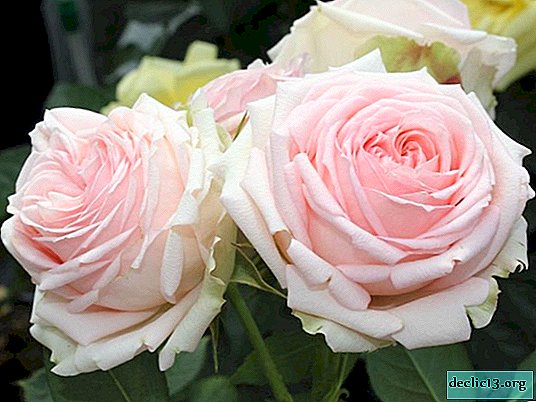

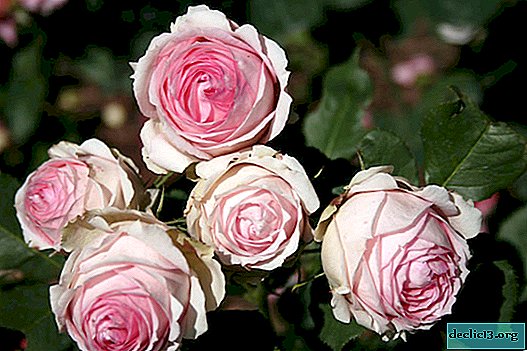

History of occurrence
The variety was bred in 2005 in Germany in the Tantau nursery.
What is the difference from the rest of the species?
The First Lady is distinguished by luxurious flowering.
Bloom
- When and how? The rose blooms several times during the warm season with short breaks. Care before and after flowering - especially In spring, before flowering, the soil is fertilized with nitrogen, in September, potassium top dressing is applied.
- What to do if it does not bloom? The lack of flowering may be a signal that the rose is improperly or insufficiently looked after. It is necessary to check whether the rules of its maintenance are followed. If errors are made, adjust the care schedule.
Flowering depends on weather conditions. If cloudy, cool days prevail, the buds may not open or form. In this case, it remains only to wait for a sunny summer.
Use in landscape design
Specialists recommend growing the First Lady as a tapeworm - in single landings, located separately from the group. First Lady bushes look great on the background of a lawn or lawn. Single plantings of these roses can also be created in the foreground of a flower arrangement.
Step-by-step care instructions
Seat selection
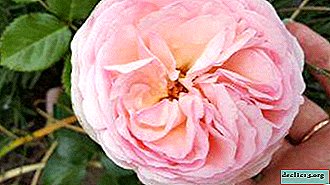 The site for First Lady must meet the following basic requirements:
The site for First Lady must meet the following basic requirements:
- Good lighting. If a plant is planted in the shade, its stems will stretch and thin. In addition, sun deficiency increases the risk of developing diseases.
- Fresh air circulation.
- Protection from the north winds. It is good if the plantings are closed from the flow of cold air by trees or shrubs growing nearby.
- The place should not be located on a hill. Otherwise, the roses will begin to suffer from strong winds and dry soil.
- The depth of groundwater is at least 100 cm.
Timing
First Lady should be planted in the spring, in April-May. Autumn planting is acceptable, but in a very short time, so that the seedlings have time to take root.
What should be the soil?
A light, loamy soil with a high humus content is ideal for First Lady. The soil must be slightly acidic, permeable to moisture and air. First Lady is developing normally on black soil. Clay soils are improved by adding compost, humus and sand to it.
Sandy and sandy soil is categorically not suitable for growing roses. It does not retain nutrients, it quickly overheats in the summer and freezes in the winter. However, such soils can be adjusted - add rotted manure, peat and lime.
Landing
Use seedlings. Quality seedlings have a flat root neck, a multi-level root system and a well-developed above-ground part without dry elements. Before planting, the seedlings are kept in water for 4-6 hours.
Landing Sequence:
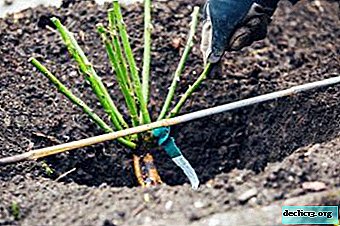 Dig a hole about 60 cm deep in the area.
Dig a hole about 60 cm deep in the area.- At the bottom, place a layer of drainage 10 cm high. You can use small pebbles, large gravel.
- Lay compost or rotted manure with the next layer. Layer thickness 10 cm.
- Top up garden soil.
- Make a hole.
- Lower the roots of the rose for a few minutes in a talker prepared from water and clay soil.
- Spread the roots and place in the hole. The root neck should be 3 cm below the surface.
- Fill the roots with soil, slightly compact the soil. After compaction, the root collar should be located below the surface of the earth.
- Pour the seedling under the root. Add earth if necessary.
- Mulch the soil around the rose with peat.
Temperature
First Lady tolerates frosts well to -23 ° C. The optimum temperature in the warm period is +20 ° C.
Watering
The First Lady should be watered at least once every seven days; on hot days, watering should be done more often, at least twice a week. One bush requires 15-20 liters of water. To avoid insect attacks and disease, you should not pour water on the leaves, buds and stems of the plant. Water should not be cold. In September, watering is stopped.
Top dressing
In spring, roses are fed with nitrogen, in the summer with phosphorus and potassium.
Weeding
It is necessary to monitor the state of plantings and systematically clear them of weeds.
Mulching
The soil around the bush is mulched with sawdust.
Loosening
After each watering, the soil is loosened carefully.
Pruning
In the spring, as soon as the buds appear, they carry out a full pruning. Depending on the purpose of the procedure, it can be:
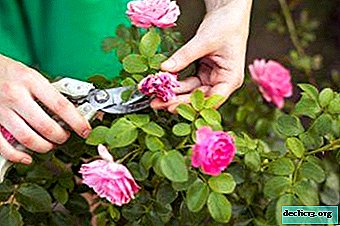 Strong - 2 to 4 buds are left on the shoots. In this way, cut seedlings after planting, as well as rejuvenate old plants.
Strong - 2 to 4 buds are left on the shoots. In this way, cut seedlings after planting, as well as rejuvenate old plants.- Average - leave 5-7 kidneys. This stimulates early flowering and maintains a high decorative effect.
In spring, the tops of shoots and branches damaged by frost are cut.
In summer, a weak pruning is carried out - faded buds are removed along with the tips of the shoots. In the fall, sanitary pruning is necessary. Remove sick and weakened shoots, thin out overgrown bushes.
Important! You need to know on which shoots the rose forms bushes: on the stems of the current year or last.Transfer
When transplanting, the transshipment method is used.
Preparation for winter
- In September, potash fertilizers are added. Stop loosening, watering, weeding and pruning bushes. Fallen leaves are removed and burned.
- Leaves are removed to a height of 50 cm. The lower part of the rose is pollinated with ash.
- Spud plants with sand. You need to do this before the first frost.
- After establishing negative air temperature, cover First Lady. Bend the stems to the ground on the stacked spruce branches or boards. Remove unripe shoots. Wrap the bush with a dense non-woven material in 3-4 layers. Place a ruberoid on top.
Breeding
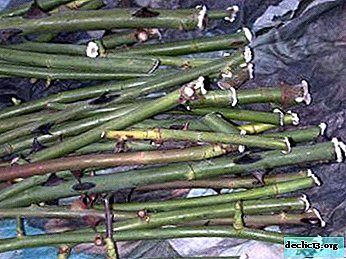 Only vegetative propagation allows young plants to retain varietal traits.
Only vegetative propagation allows young plants to retain varietal traits.
The most popular way is grafting.. Cuttings are obtained from semi-lignified shoots. Cut them when the shoots form buds or immediately after flowering. To cut, choose the early morning.
- Cut shoots from a rose.
- Cuttings with 2-3 leaves are cut from the center. Each length is from 5 to 8 cm. The lower section should pass obliquely under the kidney itself, the upper one 1 cm above the kidney.
- Before planting, the cuttings are placed for 18-20 hours in the root stimulant.
- Rinse with clean water.
- Planted in the soil obliquely, deepening by 1.5-2 cm.
- Cover with glass or plastic containers or film.
- Moisturize several times a day. It is better to use a spray gun.
- About a month later, roots form. Remove the shelter.
Diseases and Pests
First Lady is highly resistant to diseases and pests. First Lady is practically not afraid of powdery mildew and black spotting.
First Lady is inherent in high decorative qualities. Rose conquers with its chic flowering. The bush, decorated with luxurious buds, will decorate any site. The plant has good resistance to adverse weather conditions.

 Dig a hole about 60 cm deep in the area.
Dig a hole about 60 cm deep in the area. Strong - 2 to 4 buds are left on the shoots. In this way, cut seedlings after planting, as well as rejuvenate old plants.
Strong - 2 to 4 buds are left on the shoots. In this way, cut seedlings after planting, as well as rejuvenate old plants.


